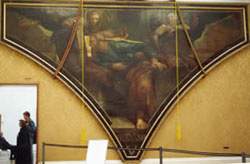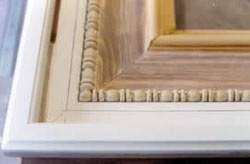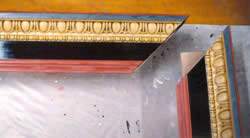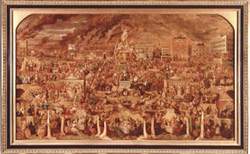For a frames conservator, making a replica frame for a painting is always a challenging project. Determining what frame is correct for the period demands extensive research in a field that is still young in terms of connoisseurship.
Choosing to construct a replica frame
The Worship of Bacchus 1864 by George Cruikshank, was restored by Tate in 2001 prior to it going on display. As part of the restoration, it was decided that a new frame should be made for the work.
The first stage of the project was to consult with the collection curators. During this discussion, it became clear that there was no information regarding the design of this painting’s original frame. Therefore, it was decided that a new replica frame should be constructed. This new frame should be historically and visually appropriate, relatively simple to manufacture and capable of being taken apart given the large size of the canvas (approximately 2.5 by 4 metres).
The final frame design: a contemporary hybrid
The final design agreed on could be said to be a hybrid of the frame around Alfred Stevens’s Isaiah 1862 (Fig. 1) and the mid-century frame around Progress 1902–3 by George Frederic Watts (Watts Gallery, Compton, Surrey). Both of these frames have applied English Composition decoration and are gilded with black lacquer friezes, a combination of effects that can be traced back a hundred years in England.

Fig.1 Alfred Stevens Isaiah 1862, Oil on paper
support: 4572 x 7925 mm, on paper, unique

Fig.2 Section drawing of the new frame for Cruikshank’s The Worship of Bacchus
When the design was finalised, an accurate section drawing was made (Fig. 2) showing how the frame was to be made using nineteenth-century techniques. The conservation technicians then machined and put together the construction in softwood.
Decorating the frame: aesthetics, accuracy and durability
Frames conservators whitened up the completed frame sections (Fig.3) and applied the decoration in cast plaster. For the decorative ornaments in this replica frame, plaster was chosen rather than English Composition which would have been used in the period frames from which the design of the new frame was derived. This is because composition can shrink and crack with time.

Fig.3 The frame after whitening

Fig.4 Different coloured clays have been applied
To complete the structural work on the frame, and to prepare for gilding, different colours of clay were used (yellow, red and blue burnish) (Fig.4). These were chosen according to the type of gilding to be used, as well as for aesthetic reasons and to appear historically accurate. For example, the blue burnish was a nineteenth-century burnishing clay made with graphite.
Gilding the frame and finishing touches
The frame was then ready for gilding. Areas showing red and blue clay were water gilded, the yellow tinted ornaments were oil gilded. The flat frieze was finished in black lacquer (Fig.5).
In the final stage all surface decoration was completed and the gilding toned slightly, to emulate a degree of ageing, so that the picture and frame complement each other in style and colour, as a single unit (Fig.6).


